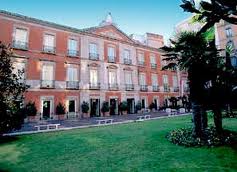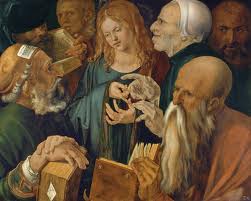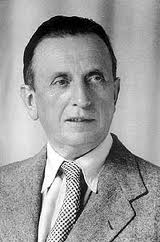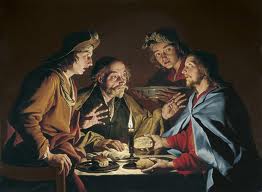Thyssen Bornemisza Museum
Where: Calle del Prado 8, Madrid, 28014
Opening Hours: 10 am to 7 pm from Tuesday to Sunday including holidays. Closed on Monday, December 25, January 1 and May 1. On December 24 and 31 the museums opens from 10 am to 3 pm.
Visit the website of the Thyssen-Bornemisza or purchase online tickets in advance.
The Museum and the Collection
The Thyssen-Bornemisza Museum opened its doors in 1992, completing along with El Prado Museum and the Reina Sofia Museum what is known as the Art Triangle, the highest and most important concentration of art in Europe. In 2010 it received more than 1,100,000 visitors from all over the world, making it the 56th most visited museum in the world. The building that hosts the museum is the Villahermosa Palace, and it exhibits around 1,000 pieces, though its collection is substantially larger, with much stock in storage and exhibited in Barcelona. Any good Madrid city guide will feature a visit to this museum among the important to-do activities in the city.
Thyssen-Bornemisza's art collection spans many centuries, from Gothic pieces of the 13th century to masters of the 20th century, making it a comprehensive exhibition of different eras and schools of art.
Italian Collection : from 13th century precursors to the Renaissance 17th century classicist art, this section covers many Italian schools and tendencies. The artists featured range from Luca di Tommè, with his Adoration of the Magi, Simone Martini's Saint Peter and Fra Angelico's The Madonna of Humility, among others.
The Italian Quattrocento is represented by many masters who are absent from El Prado Museum, such as Domenico Ghirlandaio with his Portrait of Giovanna Tornabuoni and Bramantino with the Christ Risen. Fra Bartolommeo, Piero di Cosimo, Sebastiano de Piombo are also featured among many others.
Other Italian painters that are not classified in this school of art but feature prominently in the museum are Rafael with his Portrait of a Young Man, Simon Vouet's The Rape of Europa. Titian, Tintoretto, Caravaggio and Maffei.
German Renaissance: With 40 pieces of this period and school of art, this section of the collection includes works by Dürer (Christ Among the Doctors), Hans Holbein the Young, with his famous Portrait of Henry VIII and some important samples of Hans Baldung Grien (Adam and Eve and Portrait of a Woman). It also displays paintings by Hans Holbein the Old, Chistoph Ambergen, etc.
The Netherlands: Although Thyssen-Bornemisza's examples of early Flemish paintings does not equal that of El Prado, it does possess the only Jan Van Eyck in Spain, with his breathtaking Annunciation Diptych. Additionally, there are some remarkable pieces by Jan Gossart (Adam and Eve), Joos van Cleve, Petrus Christus, etc.

From the Dutch Baroque there is a Self Portrait by Rembrandt, as well as representations of Joachim Wtewael and Frans Hals. Genre scenes masters such as Adriaen van Ostade and Jan Steen, still lifes by Willem Kalf and other important names such as Pieter de Hooch and Pieter Jansz Saenredam are also featured in the museum.
Other important painters featured in the museum, previous to Impressionism are Watteu, Boucher, Chardin among others as representatives of the Rococo school of art, and Thomas Gainsborough and Thomas Lawrence representing the English school of art.
Impressionism: the museum has valuable samples of many great masters: Manet, Renoir, Monet, Degas, Pissarro, Van Gogh (four paintings) Gauguin. Toulouse-Lautrec, etc.
20th century: The 20th century section is among the most important of the Thyssen-Bornemisza museum. Fauvism has only a few samples on display, but cubism, Russian constructivism and German expressionism have a notable presence. No less than 8 Picasso paintings can be admired in the permanent exhibition. Surrealism, figurative and abstract art are also well represented with paintings by Richard Lindner, David Hockney and Roy Lichtenstein among others. The museum also owns three paintings by Lucien Freud.
But that's not all, important names you will also see in this section include: Kandinsky, Klee, Mondrian, Chagall, Joan Miró, Jackson Pollock, Salvador Dalí, Francis Bacon, Roberto Matta. Many of these painters are not present in any other museums of Spain, so if you ever come to learn Spanish in Spain, the Thyssen-Bornemisza Museum is the place to go.
Thyssen-Bornemisza's history, from private collection to museum
Most people who visit Spain are quite impressed by the history of the Thyssen-Bornemisza museum. The collection of the Thyssen-Bornemisza was actually the private collection of the I Baron Heinrich Thyssen-Bornemisza. The family was rich and the Baron an industrialist and art collector. Perhaps the Baron inherited his love of art from his father August, who had commissioned several sculptures to Rodin. Between the mid 1920s and 1936 the family added some of their best works of art, and the collection was enhanced with paintings by Dürer, Jan van Eyck and Caravaggio. According to some versions, the acquisition of these paintings were possible thanks to the hectic activity in the arts market during the years of the recession and the period between the two World Wars.

The II Baron Thyssen-Bornemisza's first task was to unify the collection, dispersed among all his siblings. But not all works of art could be recuperated and, for instance, the Cupid by Rembrandt was sold in 1995 and is now displayed in the Liechtenstein Museum, in Vienna. From 1965 the inherited and recovered collection was enhanced by many more works of art, as Thyssen-Bornemisza spent resources and time in adding more important paintings to his collection. Besides paintings, the Baron also purchased a large number of drawings, sculptures, ivory carvings, silver objects, furniture and carpets. It was one of the most valuable private collections in the world.
The II Baron Thyssen-Bornemisza married a Spanish woman, called Carmen Cervera, and the couple continued with the family's art collection tradition, buying art from previous centuries as well as many Impressionist paintings. They went together to exhibitions and auctions, and Carmen's influence would be instrumental for the future of the collection.
Heinrich Thyssen kept his collection spread between many of his houses and the idea of uniting them all under one roof and exhibit them lead him to study several offers from European countries. There were offers from the US, including one from Disneyworld, the Museum Paul J. Getty, and from Japan. It would be the last opportunity for any city or country to house such and important and extensive collection that included not only Impressionist art and many Picassos, but that also featured many artists whose paintings were no longer in the market. Buying a whole collection together would be a lot cheaper than acquiring them one by one.
But the Baron set many specific conditions that immediately ruled out many possibilities: the Thyssen-Bornemisza collection had to be preserved as such, housed in its own museum, keeping its name and profile as a family collection. The Getty museum wanted to acquire the collection, but it intended to add the works to their already huge collection.

Finally the Spanish government presented an offer accepting all of the conditions, and including the Palacio de Villahermosa as venue to host the museum. Nevertheless, the agreement between the government and the Baron was somewhat unorthodox, first signing a leasing contract for a maximum period of 9 and a half years, for a sum of 500 millions pesetas (3 million euros) a year. This measure was taken because Thyssen-Bornemisza wanted to ensure the government would fulfill its part of the deal. Only a year later the Thyssens agreed to sell 775 pieces, all of them of great importance (known as the indivisible core) for a price of 350 million dollars, subtracting the sums already paid for their lease.
Not everyone agreed at first and there were heated arguments between congressmen as they considered the amount of money excessive. But the Baron's purpose was not to profit from the sale – on the contrary, by selling the collection as a whole, instead of auctioning each piece individually, the Baron was actually losing money. His wish was to ensure the survival of the entire collection as one, and in fact the money he received was divided among his heirs as compensation to avoid claims, as had happened when his own father died. If you ever visit Madrid you will have the chance to see one of the best art collections in Europe.
Almost 20 years of its opening, Carmen Thyssen, the Baron's widow and also a great patron of the arts, leant the museum for 15 years a total of 230 artworks by great masters (including Goya and Picasso) of her personal collection.



